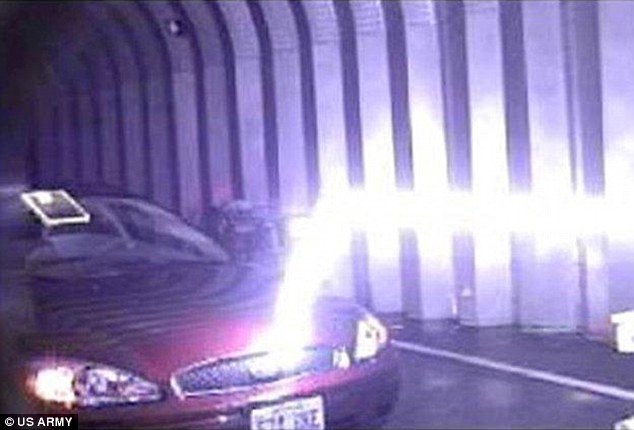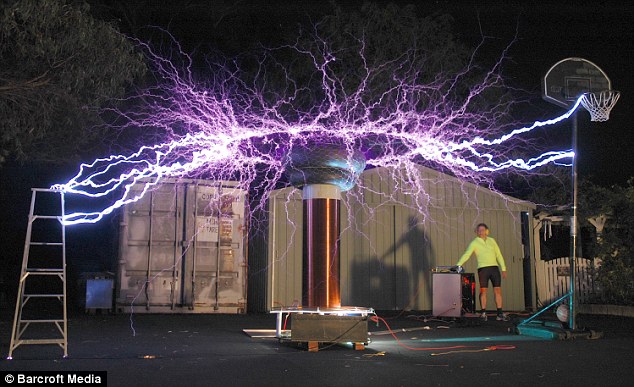
U.S. Army develops Tesla-style lightning bolt to destroy enemy vehicles (and adds: ‘Sci-fi fans, you’re welcome!’)
From Truther
The United States Army’s team of scientists are busy at work developing a device that will shoot lightning bolts down laser beams to destroy its target.
And they are doing it with gusto – announcing their work with a hearty: ‘Soldiers and science fiction fans, you’re welcome.’
The Laser-Induced Plasma Channel, or LIPC, is designed to take out targets that conduct electricity better than the air or ground that surrounds them.
And the research is a lot of work, but as George Fischer, lead scientist on the project, said: ‘We never got tired of the lightning bolts zapping our (simulated) targets.’

Quick fire! A guided lightning bolt travels horizontally, then hits a car when it finds the lower resistance path to ground
The idea is for a laser beam to be sent in the direction of the target.
When it approaches, the target, such as an enemy vehicle, will be a better conductor than the ground it sits on, leading to a massive current rocketing through it.
Fischer said: ‘Light travels more slowly in gases and solids than it does in a vacuum.
‘We typically think of the speed of light in each material as constant. There is, however, a very small additional intensity-dependent factor to its speed.
‘In air, this factor is positive, so light slows down by a tiny fraction when the light is more intense.
‘If a laser puts out a pulse with modest energy, but the time is incredibly tiny, the power can be huge – during the duration of the laser pulse, it can be putting out more power than a large city needs, but the pulse only lasts for two-trillionths of a second.
‘We use an ultra-short-pulse laser of modest energy to make a laser beam so intense that it focuses on itself in air and stays focused in a filament.’
To put the energy output in perspective, a big filament light bulb uses 100 watts. The laser output is 50 billion watts of optical power.
 An unrelated light experiment: Australian Peter Terren stands by a sculpture, which uses a Tesla coil to generate bolts of electricity
An unrelated light experiment: Australian Peter Terren stands by a sculpture, which uses a Tesla coil to generate bolts of electricity‘If a laser beam is intense enough, its electro-magnetic field is strong enough to rip electrons off of air molecules, creating plasma.
‘This plasma is located along the path of the laser beam, so we can direct it wherever we want by moving a mirror.’
Tom Shadis, project officer on the program said: ‘Definitely our last week of testing in January 2012 was a highlight.
‘We had a well thought-out test plan and our ARDEC and contractor team worked together tirelessly and efficiently over long hours to work through the entire plan.
‘The excellent results certainly added to the excitement and camaraderie.’
As development continues, Shadis said that those involved with the project never lose sight of the importance of their work.
‘We were all proud to be serving our warfighters and can picture the LIPC system saving U.S. lives,’ Fischer said.
